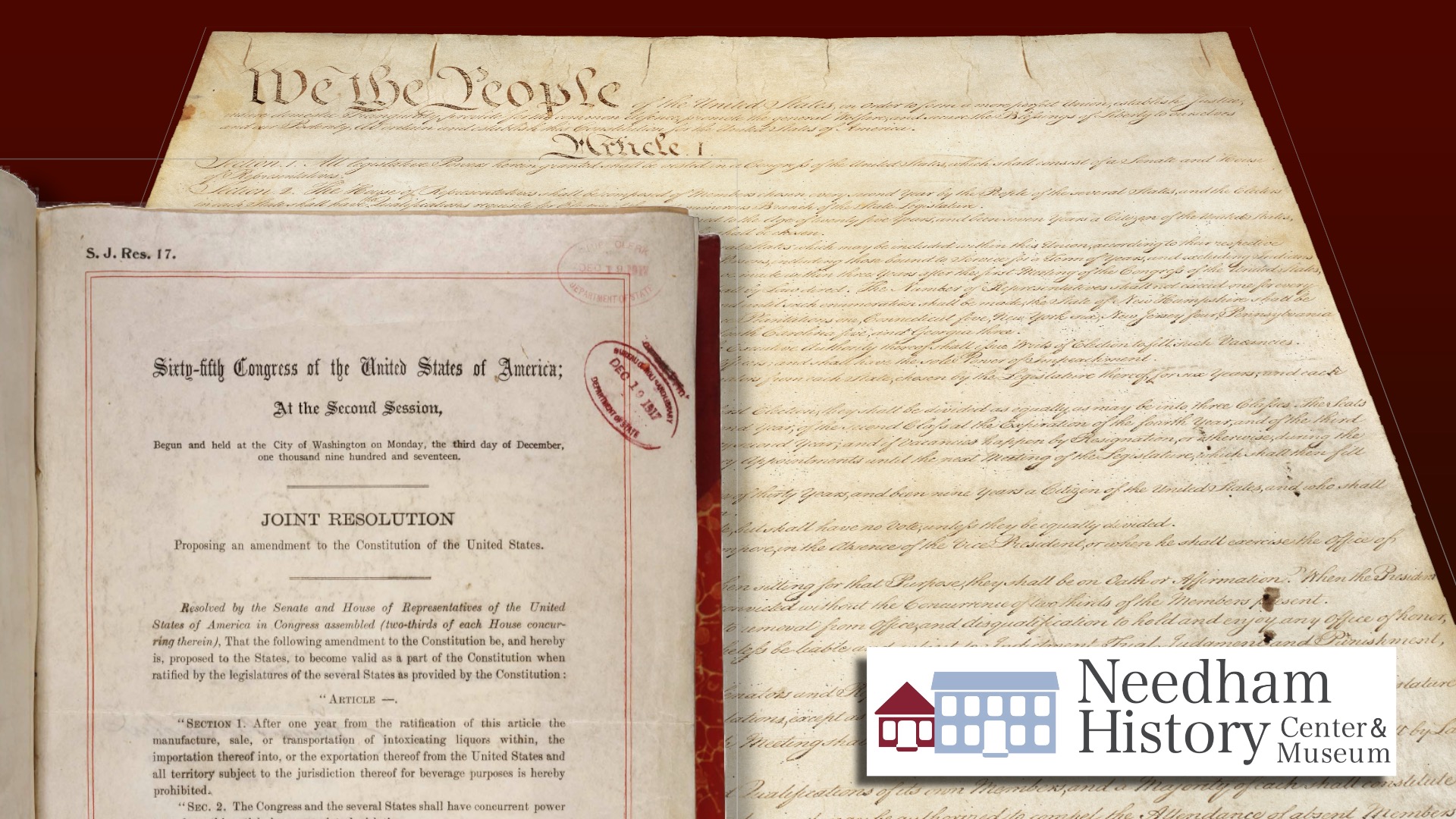
Needham History: True Bootlegger Tales!
Where there is a Will, there is always a Way.
Cast of Characters: Norman MacKenzie (right) was Needham’s first chief of Police, serving from 1912 to 1929; he started out as a night watchman in the days before Needham had a formal police force. Officer, later Chief Arthur Bliss (center) joined the Needham Police in 1921 as a patrolman; he became Chief in 1930 and retired in 1940. Frank Haddock (left) was a patrol officer in Needham. In 1934, he was one of the two policemen killed when the Norfolk Trust Bank was robbed.
True Bootlegger Tales!
The vote in 2015 to allow liquor stores in Needham ended the town’s reputation as “Dry” – despite the fact that hotel and restaurant permits had been chipping away at the restrictions for years. Since the early 19th century, Needham had developed a strong temperance movement. In 1829, Town Meeting voted “to put the law in force respecting Idlers and tavern-haunters.” Several other attempts followed, both to enforce the existing laws against public drunkenness and idleness, and to actually outlaw the sale of liquor in town; although these efforts had some support, there was not enough to pass them as law (or to effectively enforce them!)
Needham’s first temperance organization, The Needham Temperance Society, was formed in 1830. In the 50 years that followed, seven more temperance organizations were formed in Needham, several of which also included children’s divisions.
It may seem to us like this was more temperance than necessary, but in those days, Americans drank significantly more than they do now, and drunkenness was commonplace. Americans currently drink, on average, about 2.3 gallons of ethanol per capita per year – the equivalent of about 540 drinks. In the early 1800s, the total was more than triple that amount, or roughly 5 drinks per day – and that is a per-capita average, so once you exclude children and non-drinkers, the total was enormous.
The situation was made worse by the practice of using liquor as an inducement – polling places, for example, often had rum barrels supplied by the political parties. Or by paying for small jobs with liquor rather than money (common trade in small towns – not just Needham – was based as much on barter as on cash). However, men who were paid in rum often came home drunk; nor could they bring home their pay to support their families. Temperance, therefore, was considered a hearth-and-home issue and therefore a legitimate political sphere for women – and they made the most of it. Women were the drivers of the both the domestic Temperance movement, and the political efforts to pass Prohibition.
Passage of the 18th Amendment in 1920 established Prohibition as Federal law. However, the 21st Amendment that repealed it in 1933 allowed – but did not require – municipalities to permit the sale of alcohol. Needham opted to remain dry.
Even so, where there is a Will, there is a Way. As these TRUE stories from the Needham newspapers attest, there were always enterprising souls who made sure that Needham never really went without – before, during, and after official Prohibition. Here are a few samples; there were many more.
NEEDHAM POLICE SEIZE ALCOHOL WORTH $3,000
Needham Chronicle, 25 August 1923 – Alert off-duty Newton police officer, James “Happy” Conlon, became suspicious when he was asked directions by a truck driver who looked and acted a bit shifty. The policeman called the Needham Police with the license number, and a few minutes later Police Chief McKenzie and Officers Bliss, Haddock*, and Conlon came upon the truck on River Park Street, where plain tin cans were being unloaded into a barn. The contents of the cans proved to be pure alcohol, with a value of $3,000 (around $50,000 these days).
The driver was arrested, but claimed he was just hired to drive and knew nothing about the men and their cargo. His bail was set at $500. The other two men, known only as “Joe” and “Donnie,” took to their heels when the police approached. Although Officer Bliss fired his gun into the air and called on them to stop, the pair successfully escaped into the nearby woods.
The owner of the barn disclaimed all knowledge of the liquor and said he had rented the barn for use as a garage. Police say a pile of hay found in the barn would have made an ideal place to hide the cans. Police believed the shipment was just one activity of an organized gang who used Needham as a distribution point. [*NB – Officer Haddock was one of the two police officers killed in the Needham Trust Bank robbery in 1934.]
Stay away from bootleg hooch when you’re on a spree.
Take good care of yourself – You belong to me!
(Button Up Your Overcoat. Music by Ray Henderson,
Lyrics by Buddy DeSylva and Lew Brown, 1928.)
POLICE FIND BIG DISTILLERY IN OPERATION IN NEEDHAM HOME
Boston Daily Globe, 12 November 1925 – In one of the biggest hauls of the year, the Needham Police Department raided a home on Nehoiden Street, where, by the use of modern and elaborate apparatus, denatured alcohol and alcohol medicines were being re-distilled to extract their alcohol content.
The apparatus was confiscated by police, along with 10 barrels of denatured alcohol, 75 cases of rubbing alcohol, 45 gallons of distilled alcohol, 250 gallons of fermenting grape mash, 5624 pounds of grapes, and numerous crates of empty cans and bottles.
The police believed that the product was carried out of town by trucks during the night. The still had probably been in operation for only a short time before it was discovered. This was the largest of seven successful raids that were carried out by the Needham Police Department that fall.
I’ve got bail if we go to jail –
I mean, this joint is jumpin’
(Don’t give your right name. No, no, no…)
(The Joint is Jumpin’. Fats Waller, 1937)
LIQUOR RAID AT WEBSTER STREET DWELLING
Needham Times, 22 October 1936 – Silently, without disturbing a sleeping neighborhood, Needham Police and Federal officers staged a late-night raid on an illegal distillery on Webster Street. The still had been in operation for several months without arousing the suspicion of neighbors.
The raid netted the Federal agents a 500-gallon still, 200 gallons of distilled alcohol in kegs and two-gallon tins, and 5000 gallons of molasses and mash.
The water meter in the house had been disconnected to hide the tremendous amount of water being used in the distilling process, and the electric light meter had been altered so the large amount of power used in operating the plant would not show on the meter.
The building owner was arraigned in Dedham’s Federal Courthouse the same day. Needham Police had raided this same dwelling a few years before, and arrested the owner for keeping and exposing liquor for sale.
So I married the bootlegger’s daughter,
and now I’m just rolling in dough.
The way she drinks gin is a terrible sin,
but girls will be girls, as you know…
(I Married the Bootlegger’s Daughter. Frank Crumit, 1925.)
ILLEGAL ALCOHOL PLANT UNEARTHED IN ISOLATED SECTION OF NEEDHAM
Needham Times, 12 December 1935 – What was thought to be the largest alcohol plant in the Boston area was seized by the Needham police, when they raided two farms at Cheney Plain* in North Needham.
Chief of Police Arthur Bliss led the raiding party. The still had been discovered by accident when police officers responded to a call to investigate a wrecked car near Cheney Street. Observing a strong odor in the area, the officers notified the Chief and secured a search warrant.
The plant was in three buildings near an old farmhouse. The farmer said he had leased them for $10 a month to men who said they wanted to raise mushrooms. The plant was in a large barn near a carriage shed which contained seven wooden vats, each with a 1000-gallon capacity. Also in the shed were two stills; one had a 5000-gallon capacity, while the other held 1000 gallons. These were operated by gasoline burners. Over 175 feet of pipe connected the buildings to a pump house. The plant was in full operation at the time of the raid, although the premises were deserted.
The DPW carried the product to the liquor room at the Police Station, where it was turned over to Federal officers who dismantled the plant. It was estimated that the plant had been in operation for two months, causing an estimated daily tax loss of $3000 (roughly $62,000 today). [*NB – Cheney Plain was the area now bounded by Highland Avenue, Hunting Road, and Kendrick Street, incorporating Route 128, the Cabot Street area, and the Innovation District. In 1935, it was mostly the old gravel pits and sparsely-occupied.]
 |
Gloria Polizzotti Greis is the Executive Director of the Needham History Center & Museum. For more information, please see their website at www.needhamhistory.org. |

